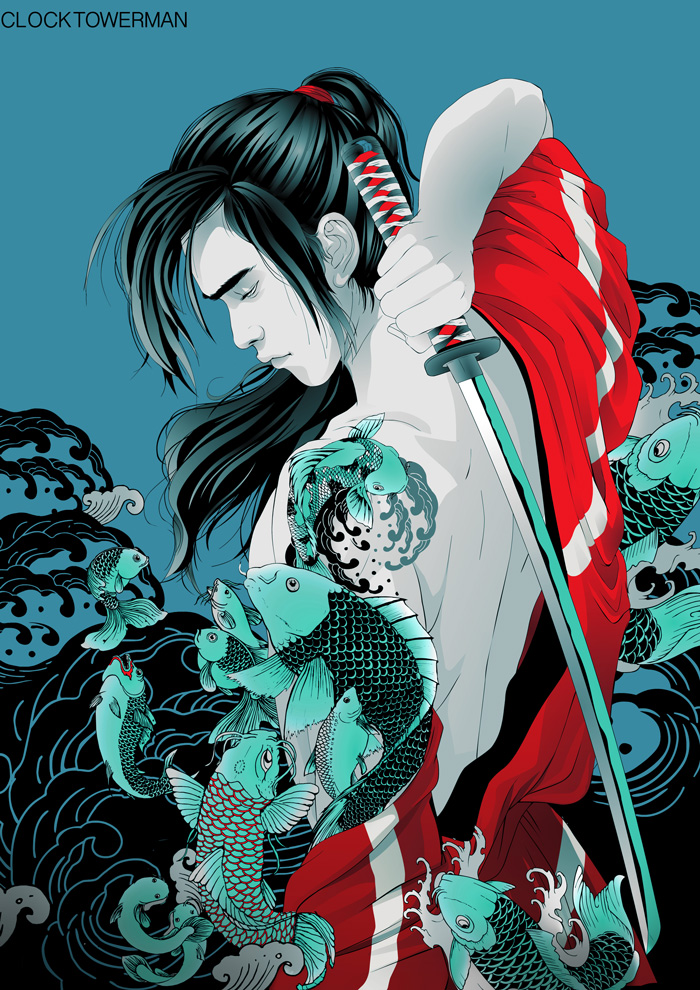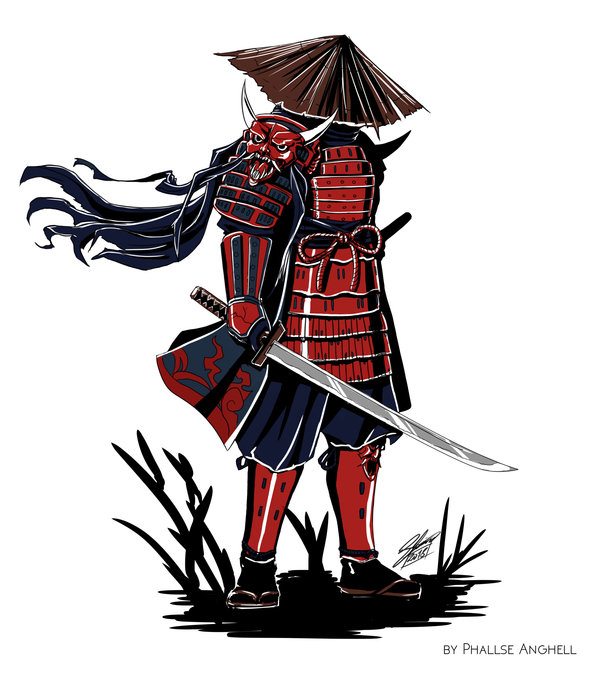 The Samurai is now culturally everywhere. Most western geeks understand the concept of Bushido code and can happily argue the difference between wakishai and a tanto. However, when it first arrived, I imagine it was an odd genre for western audiences because while it was wildly aesthetically different, it had many hallmarks recognisable in our now films. Was this due to universal constants in the human experience? Partially. But also because the Chanbara films weren’t just influenced by their own history. They’d looked pretty closely at the West too.
The Samurai is now culturally everywhere. Most western geeks understand the concept of Bushido code and can happily argue the difference between wakishai and a tanto. However, when it first arrived, I imagine it was an odd genre for western audiences because while it was wildly aesthetically different, it had many hallmarks recognisable in our now films. Was this due to universal constants in the human experience? Partially. But also because the Chanbara films weren’t just influenced by their own history. They’d looked pretty closely at the West too.
West Goes East Goes West
In the wake of World War II, a nation is shaken. In the wake of war’s end, the populace needs to be reminded that once, they were victorious and righteous. They need heroic individuals from a historic age that were paragons of recognised virtue. They need to be historical to create a comfortable viewing experience for those watching, free of the shadow of recent war. Heroes who will ride into town and clean up the place.
Now, this is quite clearly cowboys I’m talking about. Or Samurai. Or Both. What’s really odd about America’s victory and Japan’s defeat during World War II is that both outcomes created a similar social need for reaffirmation. The Japanese however decided the only way to properly rid themselves of the spectre of America was to go back to a time before America existed. Thus, in the early 50’s, the silent film Chanbara genre was reborn of a fusion of ancient stories and more modern action sensibilities.
These films showed that traditional values were the path to a successful life and reaffirmed Japan’s place in the world to its people. However, as the genre grew, it’s creators began to tell stories of the conflict between duty and the individual. The idea of the ronin hero became popular, as these were individuals who could live outside society and critique it. Much like the mutation of the cowboy in the west, the Samurai’s evolution from patriotic avatar to anti-establishment figure kept the figure more relevant in modern times. The Samurai stopped being a trusted authority supporter and became an individual constrained between the choices of what is right and what is dutiful.
 Slowly, the West’s preoccupation with freedom caught up with the samurai genre and in the sixties The Seven Samurai began its journey into being one of the most re-made movies of all time. In – somewhat unsurprisingly – the western genre. This golden hit secured the idea of the Chanbara film as genre to be plundered and four years later, A fistful of dollars retold the story of Yojimbo. By the time these films saw proper release in the west, they were familiar because American audiences knew the plots already. Yojimbo, for example, was remade not only as Dollar but also as The Warrior And The Sorceress, Omega Doom and Last Man Standing. This caused the genre to be both new and familiar when it finally made it to western eyes.
Slowly, the West’s preoccupation with freedom caught up with the samurai genre and in the sixties The Seven Samurai began its journey into being one of the most re-made movies of all time. In – somewhat unsurprisingly – the western genre. This golden hit secured the idea of the Chanbara film as genre to be plundered and four years later, A fistful of dollars retold the story of Yojimbo. By the time these films saw proper release in the west, they were familiar because American audiences knew the plots already. Yojimbo, for example, was remade not only as Dollar but also as The Warrior And The Sorceress, Omega Doom and Last Man Standing. This caused the genre to be both new and familiar when it finally made it to western eyes.
This familiarity and fondness may also explain why the cowboy genre began to die out – western audiences simply chose the Samurai as a more exotic and compelling alternative. There was definitely a period in the late 90’s and early 00’s where it felt like every hero carried a katana. It’s somewhat ironic that a symbol of patriotism and duty in the east became a symbol of rebellious counter culture in the west.
And that’s why there’s that player in your group who is trying madly to fit their samurai into your western fantasy influenced game. You’re welcome.
Examples in RPG
Here’s some RPG knowledge that will save face whilst discussing the Chanbara RPG world.
Legend Of The Five Rings: This game redefined how one approaches Samurai play. Playing L5R correctly often means a steep learning curve, with players having to work out first how to address each other and understand what it means to be a representative of the empire. It’s now a massive universe with canonically divergent timelines, separate eras of play and the most convoluted meta-plot in existence. Somehow all of this adds a sense of verisimilitude to proceedings and can invoke some really unique RPG experiences. If you put the time in, this game rewards you. AEG fifth edition is currently the top of the franchise if you can find it, Fantasy Flight have just released the beginnings of a new edition (and perhaps new timeline).
Jadepunk: Embracing the ‘western influence’ part of samurai, Jadepunk fuses the samurai action to a steampunk western and a little bit of cyberpunk fantasy setting to create something wholly original and new. It’s also a fate system game, which means its mechanics very quickly get out of the way.
Motobushido: Take samurai, set them in a semi-post-apocalyptic wasteland and make them a biker gang. Sound good? That’s because it is. Kickstarted a while back, this game is perfect for getting an approach to the genre which seems both new and traditional at the same time.
Acting With Honour
Here are some genre staples you might want to put in if you want to capture the samurai feel.
Antici….: Timing is everything in the samurai drama. As well as moments of total non-stop action, you need moments of quietness. Take time to just let a scene you’ve described breath. Allow fights to have rest periods to take in the emotion of it all. The scene in Phantom Menace when Obi-Wan and Darth Maul are on different sides of the laser field? That’s a great ‘Samurai style’ rest moment applied to a different genre.
The Cost Of Duty: A Samurai’s journey is about hard choices between following duty and doing right. Put those choices in and then do not shy away from the consequences. This might end up with PC’s killing themselves over matters of honour of forever being mentally transformed when they follow the wishes of their shogun. These outcomes are true representations of the genre and shouldn’t be ignored. Just make sure by the end of the campaign, at least for the sake of your players, a chance to get some closure should be offered.
Ronin Embargo: While the ronin is a figure that is often invoked in Samurai fiction, someone who is able to rail against society from the outside, I’d advise against letting players choose to be one. It tends to create a situation where the choices of duty matter less. The ronin is freer with their choices unless this is the game you want to play, you miss the crux of Samurai drama. Having said that, if someone would be declared ronin through their actions during the game feel free to drop the ‘ronin hammer’ on them. Just make the sure price for freedom of choice is to be universally hated and feared by most of the populace.
Sword as purity: Swords are important artifacts in the Samurai fiction and considered the perfect pure expression of thought to action. A sword is simple and immediate. This continuity of thought is to be valued. Make sure your swords are more powerful than they are in real life. Make special ones. Give them separate histories older than PCs. Make sure players are rewarded for inventing histories for any swords they have. Make sure to provide some options where the easiest solution is immediate violence. But then have that violence have consequences. If the players examine an issue more thoroughly than swordplay, it should have depth unsolvable by combat – otherwise, why has it not been solved by the sword?
Not The Common Man: Remember that samurai are walking folk heroes, a caste above that of the common person. NPC’s not on the same social level, shouldn’t question the heroes in these tales – not unless they give them reason to. Often great respect and toadying should happen, or great fear. Let the player’s choices dictate the lives of these lesser people, not only as warriors. Perhaps a local couple asks for the heroes to preside over a wedding or bless a child. Perhaps a casual comment causes a small social revolution with dire consequences.
Don’t forget the Ninja: As the Anti-Samurai, Ninja are the best. Beholden to no social restriction because the society they live in mostly agrees they don’t exist, Ninja are a great way to make noble heroes in the samurai mold shine. Able to employ underhand tactics and disappear into a vast populace, demonstrates the limitations that samurai face. Have them attack without warning and disappear into a crowd. Or attack at night in a seemingly friendly village.
Debate the Gender Roles: This one is tricky. You are going to have to look at gender roles. Some would argue that to properly represent the genre, you are going to have to have women as second class citizens who gain respect by being demure and obedient. Now, there’s no reason for a female PC to actually do any of that, but they should face at least amusement and conflict if they want to be seen as equal. As PCs, they should succeed in this mission. That’s one take, sure. But in a game, this one should really be up to any players of a female characters though. Perhaps they’ve had enough of that imbalance in real life. Some settings, like L5R, assume no gender roles for the setting in order to create an inclusive experience for all playing. The mileage on this may vary, so discuss it with players to find out how much is a good balance for that group and re-examine this regularly, especially if a new player enters the game.
That’s the end of our Samurai session. Next time we abandon Japan and travel to China in order to examine a genre Chanbara is often conflated with and look at the differences between two.

Image credits: Alexandru, Witit Karpkraikaew and Gianina Villagran, released under Creative Commons.


